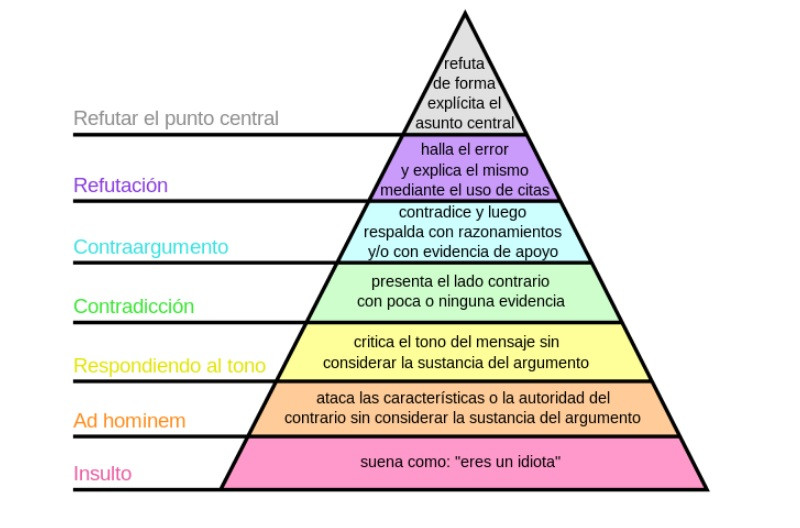Disagreement and disagreement are two aspects as inherent to human beings as the need to eat. The mere fact of being rational animals predisposes us to doubt and disagree with any opinion with which we do not fully identify.
However, not all people have the ability to do it correctly. Paul Graham noticed this fact and created a “hierarchy of disagreement” that orders the way in which people express their disagreement
Who is Paul Graham?
Paul Graham is a British-born computer programmer and essayist who became known after his work with Lisp, a family of programming languages. Additionally, he co-founded what was the first application service provider (ASP) company.
After acquiring notable fame in the computer and programming world, Graham began his career as an essayist. From his own website he published essays on a variety of topics which contained everything from texts about programming languages to the reasons why “nerdy” people never achieve popularity. These writings are gathered in the publication Hackers and painterswhich was released in 2004, although he had already published books on programming before.
However, one of his most acclaimed and widespread essays throughout the world was his study How to disagree written in 2008. In it, Graham graphically represents the “hierarchy of discrepancy.” which shows the different levels at which a person can express their disagreement or disagreement with any topic.
However, before explaining what this hierarchy is about and how it is organized, it is necessary to know what the discrepancy consists of and how its dynamics work.
What is discrepancy and how does it work?
The Royal Academy of the Spanish Language defines “discrepancy” with two different meanings:
- “Difference, inequality that results from the comparison of things with each other.”
- “Personal dissent in opinions or conduct.”
Therefore, and according to this own definition, a person who disagrees is one whose beliefs, thoughts or behaviors do not coincide with those of some other person or group
However, the discrepancy is a social fact. That is, in order to disagree with something, the presence of another person or group of people with whom to compare opinions and disagree is necessary; and also a group of followers who support our point of view.
Thus, the social level the discrepancy follows a path. A series of guidelines that range from the origin of the disagreement to the disagreements generated within this first discrepancy. Although complex, this process is much easier to understand if we follow each of the steps:
- Existence of an ideology or thought supported by numerous followers.
- Within this same group of people someone generates a discrepancy, propagating one’s own belief or opinion and creating a separation within the first group.
- Both parties acquire a large enough number of followers to maintain said opinions over time.
- Discrepancies continue to appear within the groups themselves that generate new groups of people, thus ending the original groups. This dynamic is repeated successively.
Because the tendency to disagree is something natural for human beings, due to the mere fact of possessing the capacity for reasoning, these dynamics are maintained over time and appear in all areas of life.
Graham Discrepancy Hierarchy
Once we know how discrepancies work, we can go on to describe how these disagreements can manifest themselves in each of the people who experience them. Since expressing disagreement through an insult is not the same as doing so by resorting to solid and rational argumentation.
To do this, Graham creates a graphic representation with a triangular shape in which these levels of discrepancy are ordered. According to this triangular graph, the higher a person’s location in the pyramid, the more powerful their position or argument is, while the those at the lowest levels use weak and banal arguments to justify themselves.
However, a person is capable of evolving or moving between different levels. In this way, the higher people are placed in the levels, the the more edifying and fruitful the exchanges of opinions will be

Below we explain the different levels of the discrepancy hierarchy from the lowest to the highest of all.
7. Insult
The lowest level of argument It is where all those people who resort to insults as a form of opposition are installed, given that they are incapable of offering any type of argument, no matter how poorly reasoned it may be.
Graham exemplifies this with the phrase “you’re an idiot.”
6. Ad hominem
The author places on this step all those who “attack the characteristics or authority of the opponent without considering the substance of the argument.”
This means that the person is only capable of refuting another through attacks or negative statements about him or her, with the intention of discrediting him but without providing any valid argument that demonstrates the weakness of the other’s reasoning and statements. That is, the person is attacked, not what he says.
An example of this discrepancy would be: “What are you going to know if you don’t even have an education?”
5. Responding to tone
In these cases the person focuses or uses the tone of your opponent’s message to try to deny or refute it without taking into account the foundation or essence of what is being debated.
A typical statement in these cases would be: “Screaming so much, no one will take you seriously.”
4. Contradiction
The person who uses contradiction to refute an opinion tends to express an opposite idea but with very little content or without any evidence.
In these cases the arguments used are expressed in forms of universal truths that, according to that same person, do not need explanation.
Therefore the example would be: “Everyone knows that is not the case.”
3. Counterargument
From this level onwards, the reasoning begins to present greater richness and quality. However, in the counterargument the person presents proof or evidence that supports his or her opinion, but that has been previously said or written by others.
The ideas used to debate any topic are not the result of the person’s own reasoning, but rather they use approaches and explanations from third parties to support their beliefs.
For example: “You are not right, because just as Socrates said…”
2. Rebuttal
In this second level of discussion the person is capable of reasoning and disagreeing with their own ideas and beliefs but without much regard for the basis of the argument or the beliefs of the other. Rather, it is based on very specific details or ideas from the other’s speech, not being able to refute the central idea.
1. Rebut the central point
Finally we reach the highest level, and therefore the most constructive when it comes to having a discussion. At this point the person has the necessary resources to refute the central issue or basis of the discussion explicitly and directly using their own experiences and arguments and being able to integrate the other’s ideas into their discussion.









